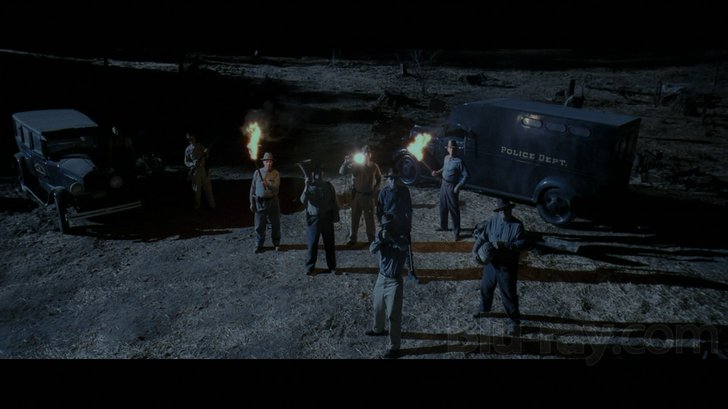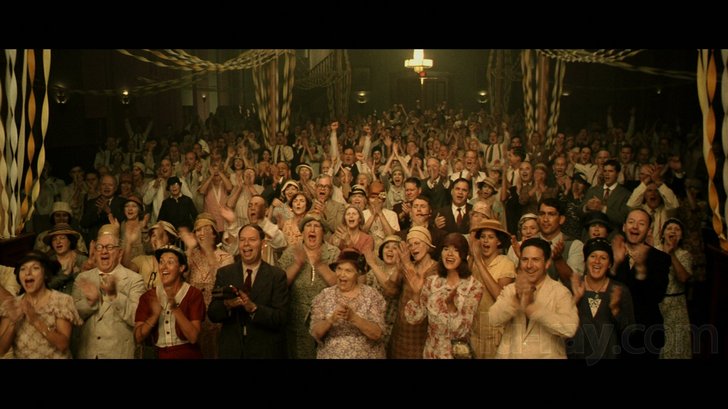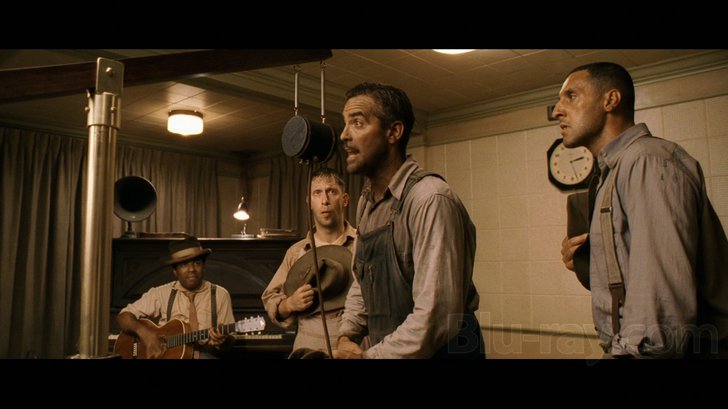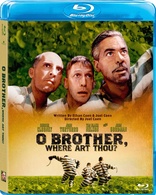O Brother, Where Art Thou? Blu-ray Movie
HomeO Brother, Where Art Thou? Blu-ray Movie 
Disney / Buena Vista | 2000 | 107 min | Rated PG-13 | Sep 13, 2011Price
List price:Amazon: $8.99 (Save 40%)
Third party: $8.99 (Save 40%)
Usually ships within 1 to 2 months
Movie rating
8 | / 10 |
Blu-ray rating
| Users | 4.7 | |
| Reviewer | 4.5 | |
| Overall | 4.5 |
Overview
O Brother, Where Art Thou? (2000)
Homer's epic poem "The Odyssey", set in the deep south during the 1930's. In it, three escaped convicts search for hidden treasure while a relentless lawman pursues them.
Starring: George Clooney, John Turturro, Tim Blake Nelson, John Goodman, Holly HunterDirector: Joel Coen, Ethan Coen
| Period | Uncertain |
| Music | Uncertain |
| Comedy | Uncertain |
| Crime | Uncertain |
| Adventure | Uncertain |
Specifications
Video
Video codec: VC-1
Video resolution: 1080p
Aspect ratio: 2.35:1
Original aspect ratio: 2.39:1
Audio
English: DTS-HD Master Audio 5.1 (48kHz, 24-bit)
Spanish: Dolby Digital 2.0
Subtitles
English SDH, French, Spanish
Discs
50GB Blu-ray Disc
Single disc (1 BD)
Playback
Region free
Review
Rating summary
| Movie | 4.5 | |
| Video | 5.0 | |
| Audio | 4.5 | |
| Extras | 2.0 | |
| Overall | 4.5 |
O Brother, Where Art Thou? Blu-ray Movie Review
"The Lawrence of Arabia of Hayseed Movies"
Reviewed by Michael Reuben September 14, 2011When Joel and Ethan Coen accepted their Oscar for adapting Cormac McCarthy's No Country for Old Men to the screen, Ethan noted that they'd succeeded by only adapting the best: Cormac McCarthy and Homer. The latter referred to O Brother, Where Are Thou?, which prominently features a credit to the legendary Greek poet and storyteller. It's noteworthy, then, that among the inspirations mentioned by both brothers in the "Making Of" featurette on the film's DVD and Blu-ray -- a list that includes the Three Stooges, Ma and Pa Kettle and Lawrence of Arabia -- Homer does not appear. The film does include obvious references to the Odyssey, but it's also brimming with references to musical lore, allusions to American history and politics, and trademark Coen word play (would anyone else turn the phrase "bona fide" into a running joke?). Then, of course, there are the usual Coen allusions to other movies, starting with the title, which is from Sullivan's Travels. If Homer were still alive, he'd be one of those authors complaining that Hollywood ruined his book (while suing for royalties). But I've had my doubts about the Homer credit ever since I first saw it when the film was released. It felt like one of those strategically placed booby traps that the Coens love to deploy against anyone tempted to become (to quote one of their titles) a serious man, studying their films like some dry academic subject. The ultimate example was the mock commentary by "Kenneth Loring" on the DVD and Blu-ray of Blood Simple, but there are many others, including the elaborate (and false) assertion that Fargo is based on a true story. (It was as if they were daring scholars to research it.) Let's forget the source material. O Brother is a comic road movie, one of the best ever made. It may be stuffed with references both obscure and obvious, because, well, that's what Joel and Ethan Coen do. But if you never get even one allusion, the film is still hilarious. Like every Coen Bros. film, it creates its own little world with its own bizarre internal logic, and it's a great place to spend a few hours.

The film recounts the picaresque adventures of three escapees from a chain gang in Mississippi of the 1930s: Ulysses Everett McGill (George Clooney), Delmar O'Donnell (Tim Blake Nelson) and Pete Hogwallop (John Turturro). Everett is the self-apppointed leader -- though Pete routinely challenges him for the position -- because the escape was his idea. He claims to have buried a "treasure" from the armored car robbery that sent him to prison, and the clock is ticking, because the Tennessee Valley Authority is about to dam up a river and flood the locale where the treasure is buried. If they don't reach it in four days, the treasure will be at the bottom of a newly formed lake. Hot on their trail is an implacable lawman, Sheriff Cooley (Daniel von Bargen), who wears mirrored sunglasses even at night and is always accompanied by a bloodhound that shows more expression than he does. The sheriff is fond of setting things on fire, and in a film rife with Christian rhetoric and imagery (some satirical, some sincere and some both), there are strong suggestions that Cooley is either the devil or, at the very least, an earthly metaphor for the fallen angel. (And that's something else you won't find in Homer.) On a more practical level, the three escapees are constantly at risk from people they encounter who attempt to betray them to Cooley for a reward. Even family members can't be trusted, because times are hard and people are desparate for any source of income. The Depression-era South through which Sheriff Cooley pursues Everett, Delmar and Pete is neither realistic nor historically accurate. It's a place of legends, myths, whoppers and tall tales, and much of the film's pleasure comes from hearing the stories told by the parade of eccentrics with whom the convicts cross paths. One of the first persons they encounter is an elderly black man (Lee Weaver) on a manually powered rail car. He gives them a ride and tells their futures, including that they won't find the "fortune" they're seeking (which should be a tipoff right there). The man happens to be blind, which has led many commentators to identify him with Tiresias, the blind seer described by Homer. But in the Odyssey, Ulysses had to undertake a perilous journey to the underworld to consult Tiresias, whereas the blind man in O Brother wheels right up out of nowhere to the three fugitives, as if he'd been sent to deliver a message. Is he Tiresias, or just one of those figures possessed of "the gift" that recur throughout Southern folklore and have been used by writers as diverse as Mark Twain and August Wilson? Does it really matter? Throughout O Brother the suggestion recurs that the real "treasure" for which the three men are searching is their own salvation. It's there in the almost ghostly scene where Delmar and Pete are baptized and saved, renouncing evil and confessing their past sins. Everett, the sceptic and man of reason, resists, but late in the film when his circumstances are dire, he falls to his knees and begs God for help -- and, depending on one's interpretation, God answers. The notion of O Brother as a quest for salvation gets a boost when the fugitives pick up a young guitarist named Tommy Johnson (Chris Thomas King) at a deserted crossroad. He says he sold his soul to the devil in exchange for musical ability, thereby repeating a famous American legend, and his description of the devil is the very image of Sheriff Cooley. (Later, when the travelers are seduced by siren-like women washing clothes in the river, it's so that they can be turned over to the sheriff for the reward -- lust leading to damnation.) Accompanied by their new traveling companion, Everett, Delmar and Pete cut a recording at a local radio station under the name The Soggy Bottom Boys, because the station owner (Stephen Root) will pay cash for a performance he likes. The song they record is "A Man of Constant Sorrow", a Job-like title if ever there was one. Little do they know that, when the station owner -- who, like the fortune teller they encountered earlier, is blind (blindness again!) -- buys their work, it will eventually change their lives. As their travels progress, the three fugitives keep narrowly missing the embattled Governor Pappy O'Daniel (Charles Durning), who is criss-crossing the state, because he's trailing in his reelection bid against a reform candidate, Homer Stokes (Wayne Duvall). Stokes's campaign rhetoric and iconography make masterful use of a new broom to sweep clean and a little person (Ed Gale) symbolizing the Little Man that Stokes will fight for. The election acquires a personal dimension for Everett when he discovers that the wife, Penny (Holly Hunter), who divorced him when he went to prison, is about to marry Stokes's campaign manager, Vernon T. Waldrip (Ray McKinnon). According to Penny, Waldrip is "bona fide", which Everett is not. To make matters worse, she's told their daughters that Everett is dead. The resolution to all this involves . . . well, what doesn't it involve? A political rally, a country music concert, a flood, a wedding ring, a Klan gathering that looks a lot like a Broadway production number -- and I haven't even mentioned the famous bank robber named George "Don't Call Him 'Baby Face'" Nelson (Michael Badalucco) or the loquacious Bible salesman with an eye patch called Big Dan Teague (John Goodman). And let's not forget the Dapper Dan hair pomade. Everett is useless without it. It's a world unto itself.
O Brother, Where Art Thou? Blu-ray Movie, Video Quality 

Aside from its intrinsic merits, O Brother, Where Art Thou? is notable for being the first American film to be finished entirely on a digital intermediate. The Coens and their cinematographer, Roger Deakins, felt that digital tools had progressed sufficiently to do the job, and Kodak was building the first DI suite at its Cinesite facility. In addition, Deakins had concluded that photochemical processing would not provide him sufficient control to achieve the "dustbowl" look the Coens wanted, especially since their shooting schedule called for principal photography during the summer, when the outdoor locations would be lushly green. In April 2010, Deakins noted on his website that "I recently supervised a new transfer of 'O Brother Where Art Thou', which looks far superior to the original release to my eye." Deakins provided no further information, but the transfer to which he referred is presumably the version on this Blu-ray, which is 1080p and encoded with the VC-1 codec. The Blu-ray image is gorgeously detailed with excellent black levels and precise contrasts that bring out minute picture elements without blowing out the whites. Consistent with the intended storybook, old-postcard look (as signaled by, among other things, the opening fade-in from, and closing fade-out to, black and white), the image is soft, but softness is not automatically a flaw in a film image. It can comfortably coexist with finely resolved detail, and that is the case here. I viewed the image on a 72" screen from about ten feet away, and there was no mistaking the quality of the image. The color pallette is generally desaturated, except for very specific effects, such as yellow-orange flames or the red of the KKK Grand Wizard's uniform. The specific tints in individual scenes -- amber here, brown there -- have already caused controversy, either because they don't match up with what some viewers say they recall from the theater or because they vary from the DVD. Even if we leave aside the likelihood that the film's cinematographer supervised this transfer, using digital tools substantially advanced from those available to him during the film's production, and found it "superior to the original release to my eye", I don't consider either of these comparisons valid. Memory is notoriously unreliable (my own included), and it's been over ten years since the film was in theaters. As for the DVD, I will never understand the desire of some viewers to pinion Blu-ray to an earlier format with a fraction of Blu-ray's resolution and a much shallower color space. If a low-resolution, limited-pallette format is going to set the outer boundaries of how one judges a film's reproduction on video, then why bother with Blu-ray at all? Watch your DVDs, save money and be content. Only in the rarest of instances will any of us have access to an authoritative source -- an answer print, original digital files, or perhaps an exhibition print struck from an interpositive -- against which a Blu-ray can be evaluated. Lacking such an objective basis for comparison, outcries based on memory, intuition, DVDs produced with outdated technology, rumors or general hostility toward studios are not a relevant basis for evaluating a Blu-ray. One should watch the disc and evaluate the quality of the image presented, noting such viewable things as black levels, color saturation, grain patterns, compression artifacts (if any), print damage (if any), etc. The Blu-ray image of O Brother has nothing in the "con" column and everything in the "pro" column. Highest marks.
O Brother, Where Art Thou? Blu-ray Movie, Audio Quality 

The audio quality of O Brother, Where Art Thou? is particularly crucial, because the soundtrack was even more successful than the film, winning multiple awards, selling millions of copies and inspiring concert tours and follow-up albums. Fortunately, the DTS lossless 5.1 track delivers everything that a fan could hope for, conveying the songs with presence, force and musicality, whether they are accompanying the action or being performed by the characters. "A Man of Constant Sorrow", which is heard twice in the film, has never sounded better. As for the non-musical elements of the track, the Coens have always been precise and imaginative in their use of sound, but they are sparing in the placement of elements in the surrounds. They prefer to keep the viewer's attention facing forward. There are moments when the soundfield expands to envelop the viewer (an example would be the revivalist meeting, sometimes referred to as "The Lotus Eaters", where a large group in white robes pass Everett, Delmar and Pete in the forest on their way to a mass baptism), but such effects are brief and rarely used. The dialogue remains clear, even though it's frequently delivered in thick, overdone accents that are the Mississippi equivalent of the extreme Minnesota accents in Fargo.
O Brother, Where Art Thou? Blu-ray Movie, Special Features and Extras 

- The Making of O Brother, Where Art Thou? (SD; 1.33:1; 8:39): This is essentially an EPK containing interviews with Joel and Ethan Coen, Roger Deakins and the principal cast members. It's informative but too brief.
- Storyboard to Scene Comparisons (SD; 1.33:1): Two sequences are covered: The Flood (6:53), and The Klan (6:19). For each, the viewer can alternate between a sequence from the film and the relevant storyboards, or place the two next to each other.
- Music Video: "I Am a Man of Constant Sorrow" (SD; 2.35:1, non-enhanced; 3:28): The video is composed entirely of scenes from the film.
- Theatrical Trailer (SD; 2.35:1, non-enhanced; 2:32): As with most Coen films, the trailer barely scratches the surface of the film's oddness.
- Additional Trailers: At startup the disc plays trailers in hi-def for Real Steel (2.35:1) and ABC TV on video (1.78:1). These can be skipped with the "top menu" button and are not otherwise available once the disc loads.
O Brother, Where Art Thou? Blu-ray Movie, Overall Score and Recommendation 

The only real criticism of this disc is the lack of meaningful extras. The presentation of the film itself is above reproach. I have enjoyed almost every film the Coens have made, which makes me an easy sell, but O Brother, Where Art Thou? is notable for its appeal even to viewers who aren't normally Coen fans. Highly recommended.
Similar titles
Similar titles you might also like

Hail, Caesar!
2016

Some Like It Hot 4K
1959

Radio Days
1987

Harlem Nights
1989

The Blues Brothers 4K
45th Anniversary Edition
1980

American Hustle 4K
10th Anniversary
2013

Harold & Kumar Escape from Guantanamo Bay
2-Disc Special Edition
2008

The Sugarland Express 4K
1974

Live by Night
2016

Dazed and Confused
1993

Bullets Over Broadway
1994

Anchorman 2: The Legend Continues
2013

Connie and Carla
2004

Life
1999

Freaky Tales
2024

Lawless
2012

Tenacious D in The Pick of Destiny
2006

Paper Moon 4K
1973

The Grand Budapest Hotel
2014

My Favorite Blonde
1942
